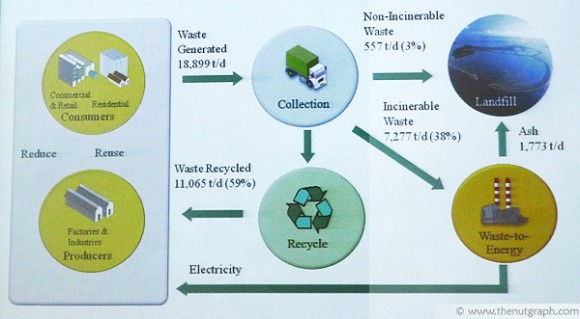by Gan Pei Ling / 12 November 2012 © The Nut Graph
FROM laptops, smart phones to digital cameras, middle class youth in the Klang Valley these days usually own a few electronic gadgets. It is taken for granted that there will be 24-hour electricity supply to power these devices. But in a remote Penan village in Upper Baram, Sarawak, 1Malaysia laptops given by the government to students have been left idle due to a lack of power supply in the settlement.
 Hollie Tu, a community organiser with Koperasi Pelancongan Penan Selungo Baram Berhad, says it demonstrates how the Malaysian government is out of touch with the living reality of rural students. “What’s the use of having a laptop when you don’t have electricity?” Tu said in exasperation when met at the Rainforest Discovery Centre at Sepilok, Sabah on 31 Oct 2012.
Hollie Tu, a community organiser with Koperasi Pelancongan Penan Selungo Baram Berhad, says it demonstrates how the Malaysian government is out of touch with the living reality of rural students. “What’s the use of having a laptop when you don’t have electricity?” Tu said in exasperation when met at the Rainforest Discovery Centre at Sepilok, Sabah on 31 Oct 2012.
What’s the use, indeed? Who else is suffering from a lack of electricity in rapidly developing Malaysia and what can the government do about it?
No electricity in Ampang…
It’s not just the Penan in Sarawak’s interiors that don’t have electricity. Official 2010 statistics show that more than one third of Orang Asli villages in Peninsular Malaysia are still without electricity supply, said Dr Colin Nicholas from the Centre for Orang Asli Concerns. Villagers often make do with kerosene lamps or candles at night. Only those better off can afford generators.
One classic case is Kampung Orang Asli Kemensah, which sits among affluent neighbourhoods in Ampang but still has no power supply till this day. Despite having their plight highlighted in newspapers since 2007, Nicholas said national utility company Tenaga Nasional Bhd just started pulling in the wires to connect the indigenous village to the grid a few months ago.
If an indigenous village located less than 30-minutes drive from our capital can be so conveniently forgotten from “development”, what will the government do for villages far in the interior?
Nicholas said the government tried to install solar panels in remote Orang Asli villages but most of these solar electrification projects failed due to poor maintenance. He pointed out that the panels and batteries require a lot of maintenance and the government did not teach the communities to maintain them.
“The government had also spent millions to install water filtration systems [to provide clean water] to villages but most couldn’t work because there is no electricity to power the pump,” said the academic-activist, speaking at the first Southeast Asia Renewable Energy People’s Assembly, a gathering of community-based renewable energy system producers across the region.
…and in Sabah
Over in Sabah, although nearly 80% of its population has 24-hour electricity supply, in its poorest district of Pensiangan, three quarters of the population have no electricity.
Adrian Lasimbang is one of the key figures helping the off-grid communities set up their own small-scale hydro systems. The trained engineer from Sabah set up Tonibung (Friends of Village Development) in 1991 which helps rural indigenous communities produce their own electricity. Tonibung installed the first pico-hydro for an indigenous village in 1999. (Pico-hydro produces less than 5kW of power while micro-hydro can generate between 5kW to 100kW of electricity.)
“Only 10% of our work involves engineering. The bulk of our time is spent getting the locals involved before the start of the project and training them to sustain the hydro system post-project,” said Lasimbang.
His organisation has helped install 15 pico- or micro-hydro systems in his home state, Sarawak and, over the past few years, in Peninsular Malaysia as well. Lasimbang noted that such small-scale hydro schemes’ impact on the environment is minimal compared to mega dams.

From the youth to the elderly, everyone gets involved in setting up the micro-hydro system for the Murut community in Kg Babalitan (© Adrian Lasimbang | Micro Hydro in Borneo)
However, Tonibung and the local communities have had to rely on foreign aid and corporations to fund their projects as they have found it difficult to source for local funding. It is disappointing that our government doesn’t seem interested in financing these small-scale and affordable renewable energy projects which provide a basic need to rural communities.
Democratising energy production
Instead, the Malaysian government tends to favour large-scale, centralised energy production projects. From the Bakun dam and the 12 proposed mega dams in Sarawak to the scrapped Sabah coal plant, local environmentalists have their fair share of controversial mega projects to protest against.
No doubt it is more energy- and cost-efficient to centralise power supply when electrifying urban areas where populations are concentrated. But the same power distribution model becomes inefficient and costly when applied to rural populations where communities are spread out. That’s why many indigenous communities in Malaysia remain off-the-grid.
 Clearly, our government urgently needs to develop a decentralised energy production strategy for its off-grid communities. Unfortunately, the Renewable Energy Act 2011 does not provide any support for the deployment of small-scale energy projects in these communities. The legislation favours urban consumers and existing corporate power producers.
Clearly, our government urgently needs to develop a decentralised energy production strategy for its off-grid communities. Unfortunately, the Renewable Energy Act 2011 does not provide any support for the deployment of small-scale energy projects in these communities. The legislation favours urban consumers and existing corporate power producers.
Power is a basic amenity, not a luxury, for our off-grid communities, and should be treated as such. Often poverty-stricken, these communities need and deserve more government aid to secure energy and clean water supply to achieve a better quality of life. Instead of free laptops and one-off handouts, the government should instead focus on long-term benefits such as ensuring that all Malaysians receive the basic need of electricity.
Gan Pei Ling thinks the budget allocated for smart phone rebate in 2013 should instead be used to fund small-scale renewable energy projects in off-grid villages. Certainly urban youths can learn to live without smart phones while some of their counterparts are having to make do with kerosene lamps.


















